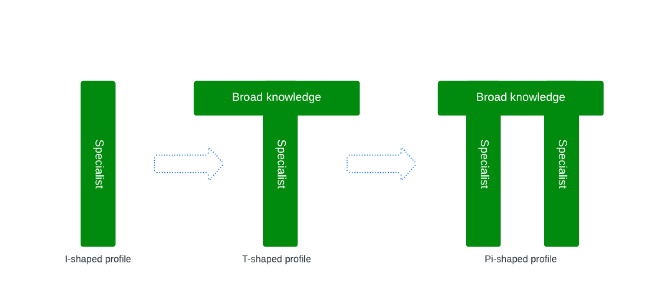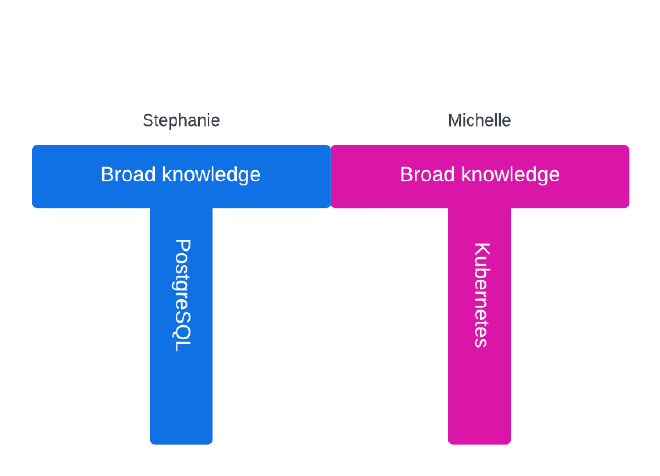The urge of “T-shaped” profiles to smooth the challenges of running Postgres in Kubernetes

Table of Contents
As Kubernetes celebrates its tenth anniversary, the integration of PostgreSQL within this ecosystem is gaining momentum, offering challenges and opportunities, rather than threats, for database administrators (DBAs). This article explores the evolution of running PostgreSQL in Kubernetes, emphasising the importance of transitioning from traditional deployment methods to a cloud-native approach. It discusses the need for DBAs to expand their skills beyond the traditional scope, advocating for a “T-shaped” or even “comb-shaped” professional profile. By understanding key Kubernetes concepts and embracing the principles of “slowification”, simplification, and amplification, DBAs can effectively collaborate with developers and infrastructure teams. This approach enhances individual expertise and contributes to the broader adoption and optimisation of PostgreSQL in Kubernetes environments. The article highlights the critical role of community and shared knowledge in breaking down silos and fostering a collaborative culture, which is essential for the successful deployment and management of PostgreSQL in modern cloud-native infrastructures.
Kubernetes just turned ten years old and shows no signs of slowing down. I am incredibly fortunate that my life and career have thrived alongside three major open-source technologies over the past three decades: Linux, PostgreSQL, and Kubernetes. Among these, PostgreSQL is my favourite. Since 2019, I have embraced a significant and, for many, risky change: running PostgreSQL in Kubernetes.
However, this risk was short-lived; within a few months, my team and I scientifically recognised the immense potential of running PostgreSQL on bare metal Kubernetes with local storage. Since then, it has been a rewarding journey to witness the growing adoption of PostgreSQL in Kubernetes, driven by our open-source CloudNativePG operator, the Data on Kubernetes Community, the CNCF, and, last but not least, my company, EDB. In a recent article, I offered my opinion on the current state of PostgreSQL databases in Kubernetes, why the adoption is increasing, and what needs to be done now after 5 years (August 2019) from the beginning of the Cloud Native initiative that led to CloudNativePG.
Although the community around CloudNativePG is growing, and the concepts we’ve been promoting through talks at conferences like KubeCon and blog articles are gaining acceptance, there is still a long road ahead to make running PostgreSQL in Kubernetes a standard practice in today’s organisations - kind of a commodity. This journey is reminiscent of the transition we experienced 20 years ago, moving from PostgreSQL on bare metal to virtual machines.
I like to describe this phase as paradoxical. While a growing user base is successfully deploying Postgres workloads in Kubernetes, there are still many deployments, environments, and organisations where improvements can be made. Decisions are being made now that don’t take into account running PostgreSQL in Kubernetes and that, for budget reasons, might slow down these organisations.
I have looked at this critically, seeking ways to improve the situation. While staring at my copy of “The Phoenix Project”, I realised that a possible answer was right before me: DevOps. DevOps has been one of my career’s most influential cultural movements and unquestionably my favourite when complemented by Lean methodologies.
Breaking the silos #
When it comes to Kubernetes and databases, silos still exist. To keep it simple, I’ll focus on some of the most evident issues I’ve observed involving development, infrastructure, and DBA teams:
- Developers: They write applications to run in containers but often need to realise they could leverage Kubernetes and PostgreSQL microservice databases, incorporating them into their CI/CD pipelines for more incredible velocity and reliability.
- Infrastructure Teams: These teams often need to know that databases can run in Kubernetes. They prefer to keep databases outside Kubernetes, running as a service in the cloud or on virtual machines/bare metal deployments. These decisions can significantly impact both developers and DBAs.
- DBA Teams: Most DBAs have little influence in decision-making regarding Kubernetes adoption. This situation often places them at a critical career crossroads: should they adopt Kubernetes, avoid it if possible, or even deny it?
Regarding the last point, I want to highlight a delicate issue some DBAs have confided in me. As a DBA for many years, I still consider myself a DBA. Depending on your career and life phase, you might need help to learn new technologies, such as cloud-native and Kubernetes. The way you are introduced to change can also lead to different reactions: enthusiasm or, in the worst case, fear. You might fear losing your job, seek comfort in familiar methods, and convince yourself that TWWADI (“The Way We’ve Always Done It”) is your only option. Rather than seeing Kubernetes and cloud-native as an opportunity, fear might lead you to think of it as a threat, triggering job security countermeasures to defend your space and isolating you even more in your silo — a choice accentuated if you are at the end of your professional career.
This article provides insights into these categories, focusing on DBAs. The key to addressing these challenges is to “amplify” the problems, breaking down silos and fostering collaboration based on a shared body of knowledge coming from all areas. This approach promotes collaborative problem-solving and drives more effective and unified solutions.
More “T” than “I” for IT Problem-Solving #
When working in silos, there is often a tendency to develop a vertical set of technical skills, becoming, for example, an Oracle or PostgreSQL expert while ignoring the broader context: the applications, operating system, underlying storage, network, or infrastructure. This siloed approach can also extend to soft skills, reducing the ability to interact with others and dehumanising relationships, often relegated to responding to ticketing system issues.
Due to their lack of generalist skills, individuals with highly specialised skills may need help to work effectively in team-based, collaborative problem-solving contexts. These skills are essential for bridging conversations with peers with vertical expertise in other disciplines or technologies. This scenario describes I-shaped profiles, which are often characteristic of people in the early stages of their careers.
When I-shaped profiles expand their skill sets to include more generalist abilities, such as soft skills or basic knowledge of different topics, they become T-shaped profiles. Adding another specialisation transforms them into Pi-shaped profiles; with more specialisations, they become Comb-shaped profiles. These latter profiles are ideal for breaking silos and thriving in collaborative problem-solving scenarios, provided effective leadership enables them to work together.

To learn more on I-shaped to T-shaped profiles, read this article.
Teamwork and The Social Circuitry #
As knowledge workers, problem-solving is complex, often delayed and impacted by miscommunication and misunderstanding. This is why a single-person initiative rarely drives innovation and successful IT projects.
Typically, these complex problems are solved by organisations, teams within an organisation, or even communities (think of open-source projects) through teamwork.
However, working in teams is not easy and requires good “coaches” with strong leadership skills, distinct from project management, authority, or power. These coaches must coordinate their multidisciplinary team of several members with T, Pi, or comb-shaped profiles to achieve a shared goal.
In their latest masterpiece, “Wiring the Winning Organization“ Gene Kim and Steven J. Spear describe organisations as sociotechnical systems where people operate on three layers:
- Technical Objects: For DBAs, this includes PostgreSQL databases; for infrastructure teams, it might consist of Kubernetes or virtualisation; for developers, it encompasses specific programming languages.
- Tooling and Instrumentation: This includes CI/CD pipelines, deployment software, observability tools, automated testing, and more.
- Social Circuitry: This layer includes the “overlay of processes, norms, and routines, the means by which individual efforts are expressed and integrated through collaboration toward a common purpose.”
While the first two layers cover a sociotechnical system’s “technical” aspects, the third layer is responsible for the social component. Social circuitry is a deliberately vague term that perfectly describes the challenges behind making an organisation or a team succeed and requires continuous observation, listening, and adaptation. Kim and Spear describe three mechanisms to move from the Danger Zone (failure) to the Winning Zone (success):
- Slowification: move problem-solving in a controlled, psychologically safe, repeatable and testable environment, rather than being in the unforgiving front line of the production system
- Simplification: take advantage of slowification to decompose more significant and complex problems into a series of smaller ones so to address them one at a time, incrementally, or via modularisation
- Amplification: make problems surface and, via the social circuitry, foster slowification and simplification that are required to iteratively solve them, through feedback and improvement loops.
When applied to our specific case of improving running Postgres databases in Kubernetes, this article aims to amplify the problems discussed at the start, initiate slowification and simplification, break the silos and deliver high-performing deployments.
A key starting point is acknowledging that increasing PostgreSQL databases will be running in Kubernetes each year. DBAs can play a crucial role in shaping the future of PostgreSQL in this environment. By mastering enough Kubernetes to manage PostgreSQL effectively, DBAs can drive the processes of simplification and optimization, enabling them to have meaningful conversations within their organisations and the broader communities. This approach not only enhances their skill set but also positions them as vital contributors to the evolution of PostgreSQL in the cloud-native landscape. The diagram below shows how T-shaped profiles enable Stephanie, our subject matter expert (SME) for PostgreSQL, to work with Michelle, our SME for Kubernetes, and build value for our organisation.

To learn more on slowification, semplification and amplification, read this article.
Learn Enough Kubernetes to Make a “T” #
If you’re running PostgreSQL directly on bare metal or VMs, consider your familiarity with Linux. Most PostgreSQL DBAs know just enough Linux to handle day-to-day operations effectively. Similarly, you don’t need to become a Kubernetes expert but acquire enough knowledge to manage day-to-day operations (and possibly day-zero planning for architecture, storage, etc.). This approach transforms your deep expertise (“I” shape) into a broader skill set (“T” shape).
Kubernetes can be complex and overwhelming, but mastering its essentials will enable you to integrate PostgreSQL effectively with the rest of your infrastructure.
Understanding Kubernetes Basics #
Kubernetes manages infrastructure and applications as code, supporting resilience, high availability, and self-healing. The goal of a Kubernetes cluster is to ensure the cluster itself becomes the single point of failure. Typically, this translates to:
- Making an entire region the SPOF in public cloud deployments, where a Kubernetes cluster spans at least three availability zones (data centres).
- Making a single data centre the SPOF in on-premises deployments, where a Kubernetes cluster resides within one data centre.
The first crucial concept to grasp is that availability zones can automate high availability for Kubernetes applications, including PostgreSQL databases, at a regional level.
Nodes and Workloads #
A level below availability zones are the worker nodes, where applications run. These nodes, running Kubernetes (often on Linux), can be on virtual machines or bare metal. For PostgreSQL, dedicating some machines to PostgreSQL workloads is advisable. Kubernetes offers several ways to manage this separation logically through configuration (node labels, taints, affinity/anti-affinity rules). You can even dedicate a bare metal server to a single PostgreSQL instance, using Kubernetes for declarative control.
The second key concept is that worker nodes are where applications, including PostgreSQL, run. You don’t need to set up the nodes yourself, but you should understand how Kubernetes schedules workloads.
Networking and Services #
Nodes and availability zones are connected by a shared network. Kubernetes
provides a Service resource that abstracts connectivity, allowing
applications to point to a PostgreSQL primary service without worrying about
which instance is accepting write operations. This abstraction holds even
during failovers or controlled switchovers.
The third key concept is understanding Kubernetes services.
Storage Management #
Storage is crucial for PostgreSQL DBAs and applies equally in Kubernetes.
Although CloudNativePG is storage agnostic, performance can vary based on
storage choice. Kubernetes uses StorageClass to provision storage
dynamically. Vendors provide storage classes that create persistent volumes
with standard interfaces, thanks to the Container Storage Interface (CSI)
initiative.
The fourth key concept is understanding how storage classes, persistent volumes, persistent volume claims, and CSI drivers work together.
For more on network and storage with CloudNativePG, see my CNPG recipe #9.
Deployments and Operators #
Applications in Kubernetes are typically deployed with a Deployment resource,
which supports redundancy, self-healing, scaling, and rolling updates. However,
stateful applications like PostgreSQL require an operator for effective
management. CloudNativePG is designed to manage PostgreSQL in Kubernetes.
The fifth key concept is getting familiar with CloudNativePG. Start with the
documentation and follow the quickstart guide or my
CNPG recipe #1.
You just need Docker on your laptop and Kubernetes running in a container using
kind.
Building Kubernetes Expertise #
Finally, consider training to build your Kubernetes expertise. I recommend Mumshad Mannambeth’s self-paced course, “Certified Kubernetes Administrator (CKA) with Practice Tests”. Dedicate an hour a day for 45 days to this class, and you’ll become a Certified Kubernetes Administrator, equipping you to run PostgreSQL in Kubernetes confidently.
By embracing these concepts and resources, you’ll be well-equipped to manage PostgreSQL in Kubernetes, enhancing your skill set and contributing meaningfully to your organisation and the broader community.
Conclusions #
The transition to running PostgreSQL on Kubernetes presents both challenges and exciting opportunities for database administrators (DBAs). To navigate this complex landscape, it’s crucial to become familiar with the interfaces and systems surrounding PostgreSQL. This includes understanding the Kubernetes ecosystem, networking, storage solutions, and the broader infrastructure. Such comprehensive knowledge enables DBAs to optimise performance, make informed decisions, and effectively troubleshoot issues.
For those who already have a passion for PostgreSQL, adopting Kubernetes offers a powerful orchestration platform that enhances scalability, availability, and manageability. Your expertise is critical as the adoption of PostgreSQL in Kubernetes grows, and your skills are essential in this evolving environment. The synergy between PostgreSQL and Kubernetes provides a unique opportunity for innovation, making your role increasingly significant.
To effectively address the challenges of this transition, it is valuable to adopt the concepts of slowification, simplification, and amplification, as discussed by Kim and Spears and mentioned earlier. These principles are crucial for breaking down silos within organisations and fostering a collaborative environment where DBAs, developers, and infrastructure teams work together. By becoming a “T-shaped” professional with deep expertise in PostgreSQL and a broad understanding of related technologies, you can effectively contribute to this collaborative problem-solving approach. Moreover, expanding further into a “comb-shaped” profile by acquiring multiple areas of expertise enhances your ability to engage with diverse teams and drive innovation.
In conclusion, mastering PostgreSQL on Kubernetes is not just a technical challenge but also a cultural shift. By embracing the principles of slowification, simplification, and amplification, and by broadening your skill set, you can become a pivotal contributor to your organisation and the broader PostgreSQL community.
This comprehensive approach will enhance your career prospects and play a vital role in successfully integrating and optimising PostgreSQL within the Kubernetes landscape.
Stay tuned for the upcoming recipes! For the latest updates, consider subscribing to my LinkedIn and Twitter channels.
If you found this article informative, feel free to share it within your network on social media using the provided links below. Your support is immensely appreciated!
Cover Picture: “Big, bigger, huge“.